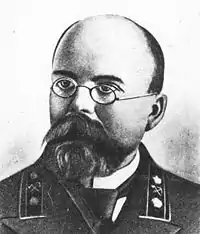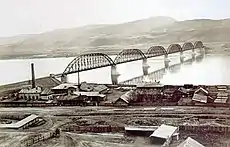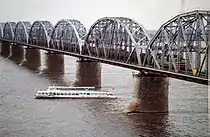Lavr Proskouriakov
Lavr Dmitrievich Proskouriakov (18 August 1858, the village of Borisovka, Voronezh Governorate – 14 September 1926, Moscow) was one of the foremost authorities on bridge engineering and structural mechanics in the Russian empire and the early Soviet Union.

Life and career
Lavr Proskouriakov was born on 18 August, 1858 into a large peasant family. In 1884, he graduated from the Saint-Petersburg Institute of Railway Engineers and began his career as a designer of bridges. Since 1887, he lectured at the same institute, and starting from 1896 Proskouriakov held the position of Full Professor at Moscow State University of Railway Engineering.
Even the early Proskouriakov's projects for bridges across the rivers Western Bug (1885) and Sula in the Ukrainian city of Romny (1887) attracted attention by their novelty and ingenuity. The drawings of these bridges were presented by Professor L.F. Nicolai, Head of the Bridge Department of the Petersburg Institute of Railway Engineers, in his tutorial on bridge design for railway engineers.[1]
During the summer of 1895, Proskouriakov was granted the opportunity to travel abroad by the Academic Council of the Institute. The purpose of his journey was twofold: first, he was to attend the prestigious International Railway Congress held in London, where he would have the opportunity to engage with experts and scholars in the field. Secondly, he was tasked with studying the mechanical institutes and bridges in various European cities, including Paris, Zurich, Munich, Vienna and Berlin. However, Proskouriakov's thirst for knowledge and desire to expand his horizons did not end in Europe. He extended his journey to the United States. His primary objective was to acquaint himself with the grandest bridges the country had to offer. With every visit to these awe-inspiring structures, he gained a deeper appreciation for their engineering, learning from local experts and discovering the secrets behind their impressive designs.[1]
Proskouriakov made a groundbreaking decision in Europe by rejecting the commonly employed lattice girder truss design that consisted of numerous vertical elements and diagonals. This particular design was highly intricate and challenging to analyze. In its place, he devised a static triangular truss that incorporated a minimal number of diagonal elements. This innovative design significantly enhanced the bridge structure's ability to evenly distribute the impact of dynamic loads.


Lavr Proskouriakov dedicated his research and practical efforts to the creation of an impeccable truss superstructure, a goal he ultimately achieved with the construction of the magnificent railway bridge spanning the Yenisei River near Krasnoyarsk. This remarkable bridge, built between 1896 and 1899, stretched an impressive 1,000 meters (3,300 ft) in length. Its truss superstructure consisted of six spans, each measuring 144.7 meters (475 ft) in length, towering at a height of 21.64 meters (71.0 ft), and weighing a staggering 900 tons.[2] To fortify the piers against the powerful forces of nature, Proskouliakov ingeniously reinforced them with massive starlings (cutwaters), strategically positioned to face upstream and effectively disrupt the downstream flow of ice during the annual spring thaw.
During the bridge design process, Proskouriakov introduced a groundbreaking truss system that incorporated the camelback truss design, similar to the Schwedler truss. This modification increased the height of the main truss to 21.64 meters (71.0 ft). Additionally, Proskuriakov incorporated the concept of influence line into the truss analysis. This allowed for more precise calculations of the internal forces exerted on each truss member due to the movement of loads on the bridge structure. This theory of ifluence line for truss analysis has since been widely adopted by engineers not only in Russia but across the globe. Furthermore, the bridge served as a pioneering example in Russia, as it was the first to employ the incremental launching method.
Due to its impressive engineering and technical features, the Yenisei Bridge gained recognition as not only the longest bridge in Russia but also the second largest in all of Europe. The only bridge that surpassed it in size was located in the Netherlands, spanning across the Lek River near Kuilenburg. The remarkable Yenisei Bridge was even showcased at the renowned Exposition Universelle (1900), where its model was awarded the prestigious Gold medal. This remarkable achievement propelled Proskouriakov, the mastermind behind the bridge's design, to the forefront of the country's most esteemed engineers. Such recognition and success eventually led to the inclusion of the Yenisei Bridge in the esteemed World Heritage List, as approved by the UNESCO.
Yenisei Bridge was incredibly groundbreaking during the era in which it was constructed. Proskouriakov's implementation of a static truss that featured subdivided panels and upward-angled top girders was later adopted and heavily utilized by numerous bridge engineers. One such engineer, Professor Nikolai Belelubsky, even borrowed this system (with minor modifications) when designing a railway bridge that spanned the Volga River in the vicinity of Sviyazhsk.
Proskouriakov successfully developed a range of optimal span designs for different types of bridges. He was responsible for creating several distinctive multi-span bridges, such as those spanning the Oka River near Kashira in 1897, Belyov Bridge in 1897, and Murom Bridge in 1912. Additionally, he designed Vyatka Bridge along the Cherepovets-Vologda-Vyatka line in 1902, Volkhov Bridge in 1902, and, of course, Khabarovsk Bridge in 1916, which formed part of the Trans-Siberian Railway. These are just a few examples of the numerous noteworthy bridge projects that Proskouriakov contributed to during his career.
Yevhen Paton compared Proskouriakov's bridges to Pushkin's poems.
In 1903, at the behest of the Society of the Moscow-Kazan Railway, Proskouriakov, along with a group of skilled bridge designers hailing from both local and international backgrounds, collaborated to create a preliminary blueprint for a remarkable bridge that would stretch across the vast Volga River near the city of Kazan. This impressive structure was intended to boast a tremendous span measuring 165 meters (equivalent to a staggering 541 feet), drawing inspiration from the awe-inspiring Yenisei Bridge.
In 1904, Proskouriakov undertook the task of designing not just one, but two magnificent rail bridges made of arched steel. These bridges, named Andreyevsky and Krasnoluzhsky, were intended to span across the beautiful Moscow River, serving as crucial components of the Moscow Circular Railway. What made these bridges even more remarkable was the fact that they consisted of double tracks, allowing for greater efficiency in transportation. Situated within the city limits, these twin bridges were not only functional, but also aesthetically pleasing. Proskouriakov masterfully crafted their design to align with the architectural standards of the time, perfectly blending into the urban landscape. The bridges' graceful appearance harmonized with the surrounding structures, showcasing the artistic vision and attention to detail of their creator.[1]

The iconic Khabarovsk Bridge, constructed during the era of Imperial Russia, stands as another significant accomplishment in the field of bridge engineering. Designed by Proskouriakov, this renowned structure spanned across the majestic Amur River near Khabarovsk. With its impressive length of 2,590 meters (8,500 ft) and a robust steel framework, the bridge was a remarkable feat of engineering. It was constructed with a single track, allowing for the smooth passage of trains. The inauguration of the bridge took place on October 5, 1916, coinciding with the grand completion of the Trans-Siberian Railroad. This momentous occasion marked a significant milestone in the transportation history of the region.[1]
Similar to Yenisei Bridge, the piers of Khabarovsk Bridge were constructed with sturdy buttresses that faced upstream and were specifically designed as inclined planes to combat the issue of ice accumulation against the piers. The bridge's overall height, measuring from the upper deck to the highest point the water surface elevation could reach, stood impressively at 12 meters (equivalent to 39 feet). This significant height allowed even larger ships to smoothly pass beneath the bridge, even during the peak summer season when the water levels in the Amur River would rise to their highest. The construction of this bridge required a substantial financial investment from the Russian state treasury, totaling more than 13 million rubles. To put this amount into perspective, it was an exceedingly large sum of money during the era in which the bridge was built.[3]
Proskouriakov was a strong proponent of the graphical method (or the dummy load method) for truss analysis that was based on the theory of influence lines. In 1891-1892, Proskuryakov gave a practical course on the application of diagrammatic statics in civil engineering. It is especially noteworthy that two years later this course became a mandatory part of the training program for railway engineers.
When designing the bridge that would span the Kotorosl River in Yaroslavl Governorate, Proskouriakov made a groundbreaking contribution: he became the pioneer in introducing a set of unique tables specifically designed for bridge builders to utilize when calculating the load-carrying capacity of bridges. This revolutionary development not only simplified the intricate process of analyzing trusses, but it also had a significant impact on the field of bridge engineering. Consequently, both the theory of influence lines and the tables introduced by Proskouriakov swiftly gained widespread acceptance and adoption in bridge engineering practices across the globe.
Education activities
Proskouriakov not only excelled as an educator and mentor to young minds, but he also played a key role in shaping the careers of numerous brilliant scientists and engineers. His colleagues and protégés, including E.O. Paton, M.M. Filonenko-Borodich, I.P. Prokofiev, P.A. Velikhov, and P.Y. Kamentsev, went on to achieve great national renown for their contributions to science. The educational principles that Proskouriakov established in the field of engineering mechanics have since been widely adopted by institutions of higher education, serving as a testament to his enduring influence.
Proskouriakov's contribution to the field of structural mechanics began in 1902 with the publication of his inaugural volume, which he titled Strength of Materials. This was followed by the release of the second volume, Structural Statics, in 1907, alongside his scientific masterpiece, The Methods for the Analysis of Continuous Truss Bridges. These remarkable works have since been recognized as invaluable additions to the esteemed collection of scientific literature. Over the course of his lifetime, Proskouriakov's two-volume handbook underwent six revisions, further solidifying its significance. Even after his passing, the seventh edition was published posthumously, and it has since been adopted as a standard textbook in technical institutes across the country.
 Pushkinsky Bridge in Moscow (1905–07)
Pushkinsky Bridge in Moscow (1905–07) Another view of Pushkinsky Bridge
Another view of Pushkinsky Bridge Bridge on the Trans-Siberian Railway in Perm
Bridge on the Trans-Siberian Railway in Perm
References
Notes
- ВЫДАЮЩИЙСЯ ИНЖЕНЕР, УЧЕНЫЙ И ПЕДАГОГ (к 150-летию со дня рождения Л.Д. Проскурякова) // Вестник Петербургского государственного университета путей сообщения. - №13 (211). - 2.12.2008. - С.2
- Канувший в Лету мост
- Амурское чудо - Издательский мост Биробиджан Archived 30 June 2015 at the Wayback Machine
External links and references
- (in Russian) "Pioneer of the Russian Bridge Science"